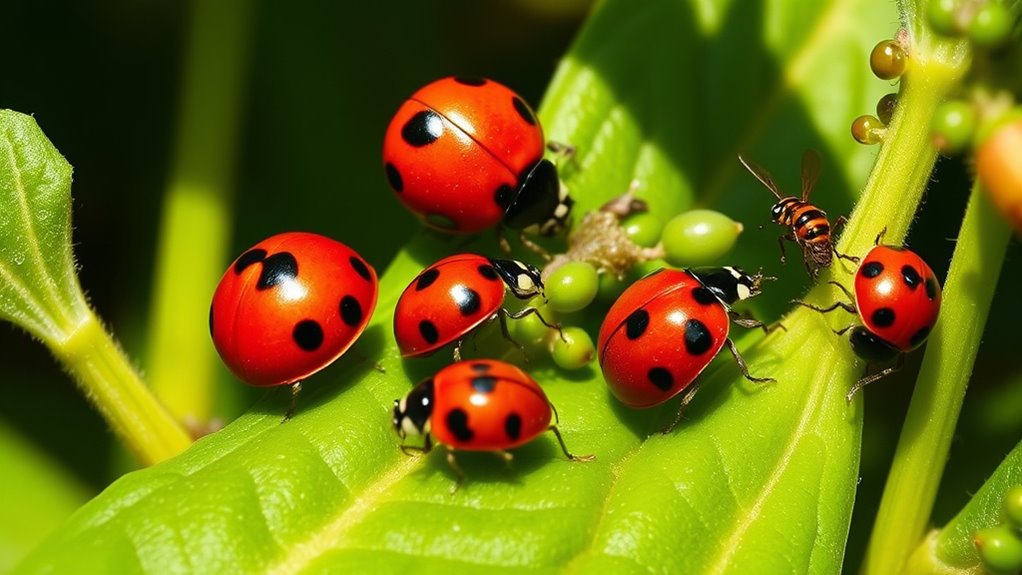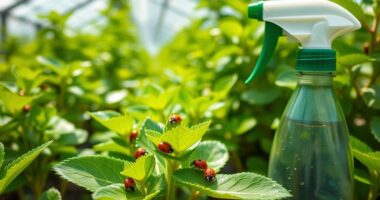Using beneficial bugs like ladybugs, hoverflies, and predatory beetles is a smart way to naturally control pests in your garden. Planting nectar-rich flowers such as dill and marigolds attracts these helpful insects, reducing your reliance on chemicals. Creating habitats with native plants and avoiding pesticides encourages their populations to thrive. These beneficial bugs actively hunt pests like aphids and mites, helping keep your garden healthy—discover more ways to support these natural allies.
Key Takeaways
- Ladybugs, along with hoverflies and predatory beetles, naturally prey on common garden pests like aphids and mites.
- Planting nectar-rich flowers such as dill and marigolds attracts beneficial insects to your garden.
- Avoid chemical pesticides to protect helpful bugs and maintain a balanced, healthy ecosystem.
- Creating habitats with native plants and shelter encourages beneficial insect populations.
- Introducing beneficial bugs through purchase or habitat support reduces reliance on chemical pest control methods.

Many bugs play a crucial role in maintaining healthy ecosystems, yet they often go unnoticed or misunderstood. When it comes to your garden, these beneficial insects can be your best allies in managing pests naturally. Instead of reaching for chemical pesticides, you can invite garden friendly insects into your space to promote organic pest management. Ladybugs are among the most popular and effective of these helpful bugs, but they’re just one piece of a larger natural pest control strategy.
Beneficial insects like ladybugs support natural pest control and promote a healthy, balanced garden ecosystem.
You might already know that ladybugs feast on aphids, spider mites, and other common garden pests. By attracting or releasing ladybugs into your garden, you create a living, breathing pest control system that reduces the need for harmful chemicals. These bugs are easy to attract by planting nectar-rich flowers like dill, fennel, and marigolds, which provide food for adult ladybugs. Providing a diverse range of plants helps sustain the entire population, ensuring they stick around to keep your pests in check. You can also purchase ladybugs from garden centers or online suppliers to introduce directly into your beds when pest populations spike.
But ladybugs aren’t the only beneficial insects that support organic pest management. Hoverflies, for example, look like tiny bees and are excellent pollinators, but their larvae devour aphids and scale insects. Predatory beetles and parasitic wasps also play critical roles in controlling pests naturally. These insects often go unnoticed, yet they’re actively hunting down pests and keeping your plants healthy. Creating a habitat that supports these garden friendly insects involves planting a variety of native plants, avoiding pesticides, and providing shelter through mulch or small ground cover.
Embracing beneficial bugs means understanding their needs and fostering a garden environment that encourages their presence. Avoid chemical pesticides, which can harm these helpful insects as well as pests. Instead, focus on organic pest management techniques that work with nature. Handpicking pests, applying insecticidal soaps, or introducing natural predators are all effective ways to keep pest levels manageable without disrupting the ecosystem. When you choose to support beneficial bugs, you’re creating a balanced, resilient garden that sustains itself over time.
Frequently Asked Questions
How Do I Introduce Ladybugs to My Garden Effectively?
To introduce ladybugs effectively, you should consider release methods and ideal timing. Release them in the early morning or evening when it’s cooler, and avoid hot, windy days. Spread them gently over affected plants or release them near pest hotspots. Make sure your garden has pollen and aphids, their food source, to encourage their stay. Regular releases during peak pest seasons can help maintain a healthy, pest-free garden naturally.
Are Beneficial Bugs Safe for Pets and Children?
It’s ironic, isn’t it? You worry about pests, but wonder if beneficial bugs are safe for your pets and kids. Rest assured, most beneficial bugs, including ladybugs, have low toxicity concerns and are safe when applied properly. Always follow safe application guidelines, and avoid direct contact during release. When used correctly, these helpful bugs can protect your garden without posing risks to your loved ones.
How Long Do Beneficial Bugs Typically Stay in the Garden?
You might wonder how long beneficial bugs stay in your garden. Typically, their release duration is about a few weeks to a month, depending on the species and environmental conditions. To guarantee population sustainability, you may need to release them periodically. These bugs often reproduce naturally, helping maintain their presence. Factors like weather and plant health also influence how long they remain active, supporting your garden’s natural pest control efforts.
Can Beneficial Bugs Control All Types of Pests?
They say “don’t put all your eggs in one basket,” and that’s true for pest control too. Beneficial bugs can’t handle all pests because of pest specificity. While they’re great at maintaining ecological balance, they often target specific pests, so you might need a combination of methods. Relying solely on beneficial bugs won’t eliminate every pest, but they’re a valuable part of an integrated pest management strategy.
What Is the Best Time of Year to Release Beneficial Bugs?
You should release beneficial bugs during the right seasonal timing to match pest activity. Typically, early spring or late spring is ideal since pests become active then, and beneficial bugs can establish themselves effectively. Avoid releasing them in winter or summer’s peak heat, as these conditions can hinder their survival. Monitoring pest levels and understanding seasonal patterns helps guarantee your beneficial bugs work their best, providing natural pest control when pests are most vulnerable.
Conclusion
By inviting beneficial bugs like ladybugs into your garden, you’re gently encouraging a balanced, thriving ecosystem. These tiny allies quietly keep pesky invaders at bay, allowing your plants to flourish naturally. Embracing their help means less reliance on harsh chemicals and more harmony with nature. So, consider welcoming these gentle guardians—your garden’s unseen champions—who work quietly behind the scenes to keep everything in delicate, beautiful order. Nature’s tiny helpers truly make a difference.









